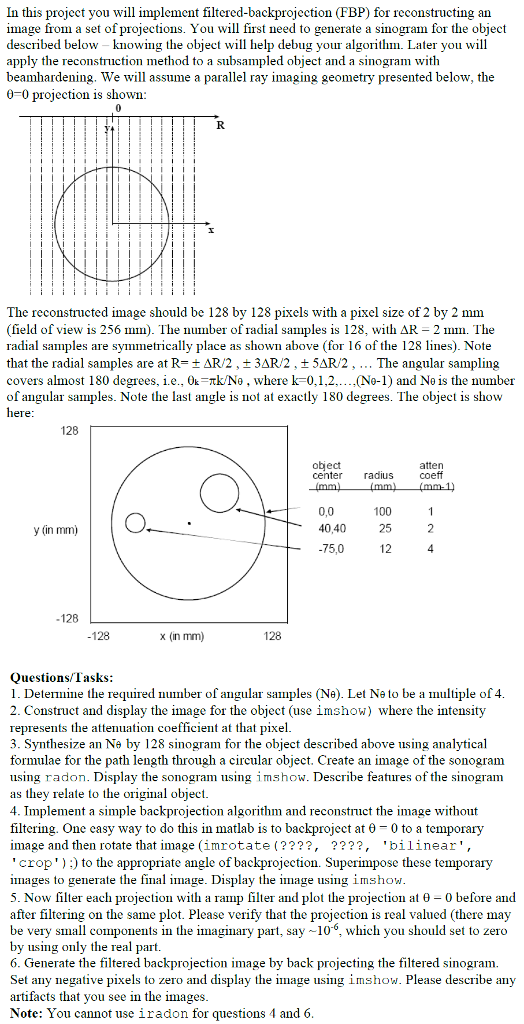Answered step by step
Verified Expert Solution
Question
1 Approved Answer
Need to solve in Matlab In this project you will implement filtered-backprojection (FBP) for reconstructing an image from a set ofprojections. You will first need

Need to solve in Matlab
In this project you will implement filtered-backprojection (FBP) for reconstructing an image from a set ofprojections. You will first need to generate a sinogram for the object described below - knowing the object will help debug your algorithm. Later you will apply the reconstruction method to a subsampled object and a sinogram with beamhardening. We will assume a parallel ray imaging geometry presented below, the 0-0 projection is shown: The reconstructed image should be 128 by 128 pixels with a pixel size of 2 by 2 mm (field of view is 256 mm). The number of radial samples is 128, with AR 2 . The radial samples are symmetrically place as shown above (for 16 of the 128 lnes). Note that the radial samples are at R t AR 2, t 3AR/2,t5AR2, The angular sampling covers almost 180 degrees, i.e., 0k-rkNo, where k-0,1,2..Ne-1) and No is the number of angular samples. Note the last angle is not at exactly 180 degrees. The object is show ere 128 object center radius coe ff O. 0,0 40,40 -75,0 100 25 14 y (in mm) 2 -128 128 x (in mm) 128 Questions/Tasks: 1. Deteine the required nunber of angular saples (Ne). Let Ne to be a multiple of4 2. Construct and display the image for the object (use imshow) where the intensity represents the attenuation coefficient at that pixel. 3. Synthesize an Ne by 128 sinogram for the object described above using analytical formulae for the path length through a circular object. Create an image of the sonogram using radon. Display the sonogram using imshow. Describe features of the sinogram as they relate to the original object. 4. Implement a simple backprojection algorithm and reconstruct the image without filtering. One easy way to do this in matlab is to backproject at ?-0 to a temporary image and then rotate that image (imrotate (????, ????, 'bilinear', 'crop'): to the appropriate angle of backprojection. Superimpose these temporary images to generate the final image. Display the iage using imshow 5. Now filter each projection with a ramp filter and plot the projection at 0-0 before and after filtering on the same plot. Please verify that the projection is real valued (there may be very small components in themaginary part, say1, which you should set to zero by using only the real part. 6. Generate the filtered backprojection image by back projecting the filtered sinogram. Set any negative pixels to zero and display the iage using imshow. Please describe any artifacts that you see in the images Note: You cannot use iradon for questions 4 and 6 In this project you will implement filtered-backprojection (FBP) for reconstructing an image from a set ofprojections. You will first need to generate a sinogram for the object described below - knowing the object will help debug your algorithm. Later you will apply the reconstruction method to a subsampled object and a sinogram with beamhardening. We will assume a parallel ray imaging geometry presented below, the 0-0 projection is shown: The reconstructed image should be 128 by 128 pixels with a pixel size of 2 by 2 mm (field of view is 256 mm). The number of radial samples is 128, with AR 2 . The radial samples are symmetrically place as shown above (for 16 of the 128 lnes). Note that the radial samples are at R t AR 2, t 3AR/2,t5AR2, The angular sampling covers almost 180 degrees, i.e., 0k-rkNo, where k-0,1,2..Ne-1) and No is the number of angular samples. Note the last angle is not at exactly 180 degrees. The object is show ere 128 object center radius coe ff O. 0,0 40,40 -75,0 100 25 14 y (in mm) 2 -128 128 x (in mm) 128 Questions/Tasks: 1. Deteine the required nunber of angular saples (Ne). Let Ne to be a multiple of4 2. Construct and display the image for the object (use imshow) where the intensity represents the attenuation coefficient at that pixel. 3. Synthesize an Ne by 128 sinogram for the object described above using analytical formulae for the path length through a circular object. Create an image of the sonogram using radon. Display the sonogram using imshow. Describe features of the sinogram as they relate to the original object. 4. Implement a simple backprojection algorithm and reconstruct the image without filtering. One easy way to do this in matlab is to backproject at ?-0 to a temporary image and then rotate that image (imrotate (????, ????, 'bilinear', 'crop'): to the appropriate angle of backprojection. Superimpose these temporary images to generate the final image. Display the iage using imshow 5. Now filter each projection with a ramp filter and plot the projection at 0-0 before and after filtering on the same plot. Please verify that the projection is real valued (there may be very small components in themaginary part, say1, which you should set to zero by using only the real part. 6. Generate the filtered backprojection image by back projecting the filtered sinogram. Set any negative pixels to zero and display the iage using imshow. Please describe any artifacts that you see in the images Note: You cannot use iradon for questions 4 and 6Step by Step Solution
There are 3 Steps involved in it
Step: 1

Get Instant Access to Expert-Tailored Solutions
See step-by-step solutions with expert insights and AI powered tools for academic success
Step: 2

Step: 3

Ace Your Homework with AI
Get the answers you need in no time with our AI-driven, step-by-step assistance
Get Started


